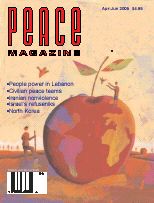
Peace Magazine Apr-Jun 2005, page 21. Some rights reserved.
Search for other articles by John Valleau here
But where do we go from here?
What a lovely surprise! I'm speaking of Prime Minister Paul Martin's sudden announcement, on February 24, that Canada would not be taking part in the US Ballistic Missile Defense (BMD) scheme. And it did come as a surprise. It was true that in the preceding weeks those of us who had been following every nuance of every government statement thought we'd begun to see the odd sign of cold feet. We began to think that after all there might be some tiny chance of citizens winning this long fight -- Steve Staples was maybe the first to express this out loud. Neverthe-less, all those misleading apologetics by Bill Graham and Paul Martin made one think there was little hope.
How should we respond?
First of all, let's declare a victory! Because it was. With a lot of hard work by a lot of people, a vast proportion of Canadian citizens gradually came to understand enough about the dangers of the BMD to make the government pay attention. As one Liberal MP put it, it was sure a help that Mr. Martin "dithers"; that gave the time needed to create a concerned electorate. And of course genuine democracy does take time; this was a victory of democracy.
Secondly, we should all congratulate Martin and the government and help to bolster their decision. There will be lots of pressure on them to reverse the decision in one way or another, or to feel that they must compensate for it by other concessions to US wishes -- that chorus has already begun, as the media fills with fearmongering about possible "retaliations" by the US. We must instead tell the government that most Canadians urge policy choices that express Canadian values and that they will therefore support a foreign policy path quite at right angles to that presently followed by our neighbors.
But thirdly, the Canadian decision won't by itself stop BMD, of course: the US will go on with it, in spite of the dangers, especially nuclear, that it represents, precisely because their military and administration are so enthusiastic about its offensive potential, not least in the possibility of enormous potential for dominating the whole world with a blanket of US space weapons. So, the BMD fight must continue. And especially now, for Canadian activists, when we have so many Canadians alert to some of the issues.
But the question that activist groups need to resolve immediately is this: How should the campaign now be focused? There are different aspects we might pursue, and if we try to campaign on all simultaneously we are going to dissipate our current momentum. What are the chief issues Canadians might pursue?
1. Space weaponry: On this subject Canadian governments have been consistent over the years in their stated opposition to the installation of orbiting weapons, so it is a hopeful area for seeking further political progress. We can imagine, therefore, encouraging our government to renew its efforts in the Committee on Disarmament and in other UN fora to seek a treaty (or a codicil to the Non-Proliferation Treaty) banning all orbiting weapons; further pressure might be brought if Canada also proposed the (final, less desirable) option of pursuing an international attempt to draft such a treaty outside the UN framework (after the manner of the landmines initiative).
2. Nuclear threats and proliferation: We have failed so far to make the public understand the horrifying nuclear implications of BMD development. A new nuclear arms race is, right now, underway. Any attempted missile defence is interpreted by Russia and China as enabling a US "first strike." The response has been nuclear expansion: Russia ceased dismantling its SS-18 and SS-19 ICBMs and restored multiple warheads (MIRVs); it is now putting in place a new series of armaments -- the SS-27 Topol-M -- and claims to have developed warheads that can "dodge" interceptors. China, which had had only a tiny deterrent force of ICBMs, is expanding its arsenal; last year it tested its first MIRVs; it is building mobile launchers and, reportedly, submarine launchers. And the weapons are being held on high alert. We are ripe for disaster.
How will India, then Pakistan, or any other nuclear threshold state, respond to such escalation? Just as distressing, our end-of-cold-war hopes for disarmament and eventual nuclear abolition, the only eventual possibility of survival, have come to seem mere pipedreams.
Canada should be urged to return to a position of leadership on these matters. It could lead on several fronts. In the short term, on alternatives to "launch on warning" tactics; in contributing to the development of high-tech monitoring techniques; and in particular by publicly urging return to conformity to the Non-Proliferation Treaty, notably by the US and the other nuclear-weapon states.
3. BMD Complicity: The new ambassador to Washington, Frank McKenna, had it partly right: whether we "sign on" to BMD or not, we are already active players. This has less to do with the face-saving NORAD arrangement than with the fact that several Canadian firms are engaged in work associated with the BMD development, and are presumably even being subsidized to do so by Canadian taxpayers. Furthermore the defence research establishment appears to be engaged in research directed toward solving technical problems of BMD design. A campaign might be organized around this; it would automatically widen, of course, to concern over the whole gamut of Canadian arms export activity: Should we be subsidizing the export of deadly weapons? Why is there no end-use restriction on the arms we sell to the US?
We almost certainly cannot fight on all fronts simultaneously and at the same time keep the public engaged. Canadian anti-BMD campaigners have to make some choices, and quickly.

Peace Magazine Apr-Jun 2005, page 21. Some rights reserved.
Search for other articles by John Valleau here